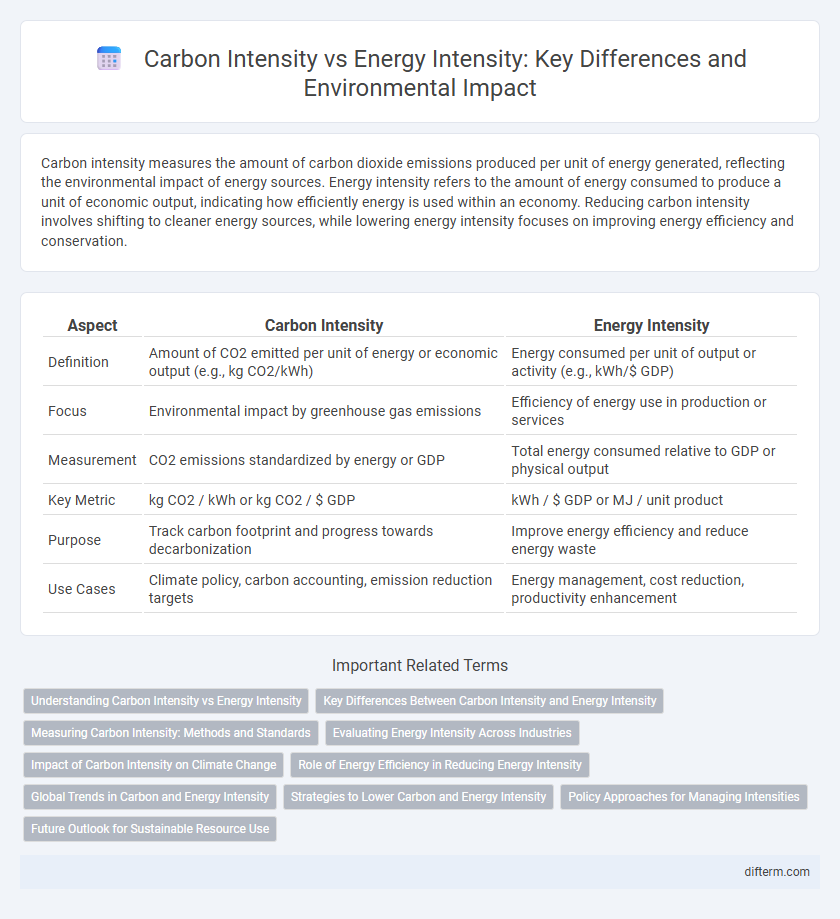Carbon intensity measures the amount of carbon dioxide emissions produced per unit of energy generated, reflecting the environmental impact of energy sources. Energy intensity refers to the amount of energy consumed to produce a unit of economic output, indicating how efficiently energy is used within an economy. Reducing carbon intensity involves shifting to cleaner energy sources, while lowering energy intensity focuses on improving energy efficiency and conservation.
Table of Comparison
| Aspect | Carbon Intensity | Energy Intensity |
|---|---|---|
| Definition | Amount of CO2 emitted per unit of energy or economic output (e.g., kg CO2/kWh) | Energy consumed per unit of output or activity (e.g., kWh/$ GDP) |
| Focus | Environmental impact by greenhouse gas emissions | Efficiency of energy use in production or services |
| Measurement | CO2 emissions standardized by energy or GDP | Total energy consumed relative to GDP or physical output |
| Key Metric | kg CO2 / kWh or kg CO2 / $ GDP | kWh / $ GDP or MJ / unit product |
| Purpose | Track carbon footprint and progress towards decarbonization | Improve energy efficiency and reduce energy waste |
| Use Cases | Climate policy, carbon accounting, emission reduction targets | Energy management, cost reduction, productivity enhancement |
Understanding Carbon Intensity vs Energy Intensity
Carbon intensity measures the amount of carbon dioxide emissions produced per unit of energy generated, highlighting the environmental impact of energy consumption. Energy intensity indicates the total energy used per unit of economic output, reflecting the efficiency of energy use in an economy or sector. Understanding the distinction between carbon intensity and energy intensity is crucial for developing strategies aimed at reducing greenhouse gas emissions while optimizing energy efficiency.
Key Differences Between Carbon Intensity and Energy Intensity
Carbon intensity measures the amount of carbon dioxide emissions released per unit of energy produced, reflecting the environmental impact of energy sources. Energy intensity quantifies the total energy consumption required to produce one unit of economic output, indicating the efficiency of energy use within an economy. The key difference lies in carbon intensity focusing on emission levels related to energy generation, while energy intensity addresses the efficiency of energy utilization relative to economic activity.
Measuring Carbon Intensity: Methods and Standards
Measuring carbon intensity involves quantifying CO2 emissions per unit of energy produced, utilizing standards such as the Greenhouse Gas Protocol and ISO 14064 for consistent reporting. Techniques include life cycle assessment (LCA) and direct emissions monitoring, ensuring accurate attribution of carbon outputs across various energy sources. Accurate measurement enables benchmarking and tracking progress toward decarbonization goals within industries and power generation sectors.
Evaluating Energy Intensity Across Industries
Energy intensity measures the amount of energy consumed per unit of output across various industries, revealing efficiency levels and potential for energy savings. Carbon intensity quantifies greenhouse gas emissions associated with energy use, highlighting environmental impacts alongside energy consumption. Evaluating energy intensity across sectors such as manufacturing, transportation, and agriculture enables targeted strategies for reducing both energy use and carbon emissions.
Impact of Carbon Intensity on Climate Change
Carbon intensity measures the amount of carbon dioxide emissions produced per unit of energy generated, directly influencing global warming and climate change. High carbon intensity from fossil fuel combustion increases greenhouse gas concentrations, accelerating temperature rise and extreme weather events. Reducing carbon intensity through renewable energy adoption and efficiency improvements is crucial for mitigating climate impacts and achieving international climate goals.
Role of Energy Efficiency in Reducing Energy Intensity
Energy efficiency directly lowers energy intensity by reducing the amount of energy required per unit of economic output, thereby minimizing overall energy consumption. Improved technologies and optimized systems in industrial processes, buildings, and transportation contribute significantly to decreasing energy intensity. Lower energy intensity supports a reduction in carbon intensity when combined with cleaner energy sources, driving progress toward sustainable environmental goals.
Global Trends in Carbon and Energy Intensity
Global trends indicate a gradual decline in carbon intensity as renewable energy sources expand, yet energy intensity remains a challenge due to rising global energy consumption. Countries like China and India are crucial in shaping these trends, showing mixed progress in reducing carbon emissions per unit of GDP while energy demand continues to grow. Innovations in energy efficiency and the transition to low-carbon technologies are pivotal for aligning global energy intensity reductions with climate goals.
Strategies to Lower Carbon and Energy Intensity
Implementing renewable energy technologies such as solar and wind power significantly reduces carbon intensity by replacing fossil fuel-based electricity generation. Enhancing energy efficiency in industrial processes and buildings lowers overall energy intensity, decreasing fuel consumption and greenhouse gas emissions. Adopting carbon capture and storage (CCS) alongside energy-efficient infrastructure upgrades accelerates progress toward sustainable carbon and energy intensity targets.
Policy Approaches for Managing Intensities
Policy approaches for managing carbon intensity prioritize the implementation of carbon pricing mechanisms, such as carbon taxes and cap-and-trade systems, to incentivize reductions in greenhouse gas emissions per unit of energy produced. Energy intensity management focuses on setting efficiency standards and promoting renewable energy adoption to lower energy consumption per unit of GDP. Combining these strategies supports national climate targets by addressing both the carbon content and the overall energy use in economic activities.
Future Outlook for Sustainable Resource Use
Carbon intensity measures the amount of CO2 emissions per unit of energy produced, while energy intensity reflects the energy consumed per unit of economic output. Future sustainable resource use strategies emphasize decreasing carbon intensity through renewable energy integration and improving energy efficiency to lower energy intensity across industries. Advancements in low-carbon technologies and circular economy practices are expected to drive significant reductions in both metrics, supporting global climate goals and sustainable development.
carbon intensity vs energy intensity Infographic

 difterm.com
difterm.com